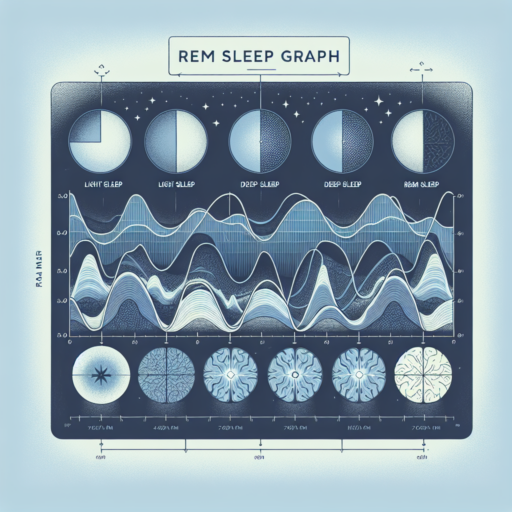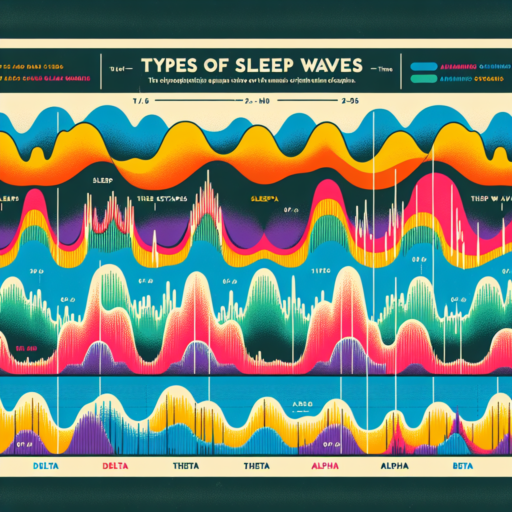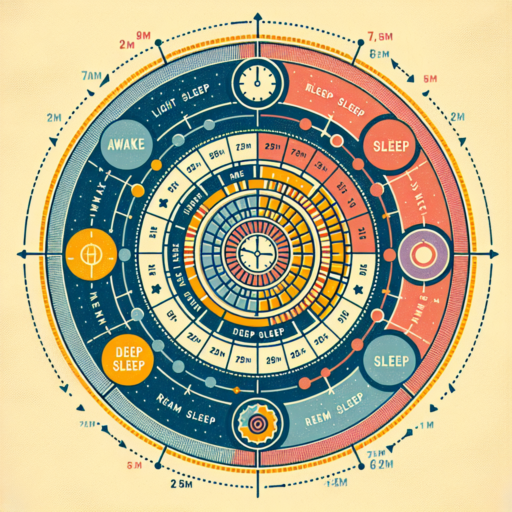What is REM Sleep and Why It’s Important
REM sleep, or Rapid Eye Movement sleep, is a unique phase of the sleep cycle characterized by quick, random movements of the eyes. This stage of sleep is notable for its high brain activity that closely resembles that of being awake. During REM sleep, the body experiences temporary paralysis of most voluntary muscles, preventing individuals from acting out their dreams. It’s during this phase that most dreaming occurs, making it a topic of fascination and extensive study in the realm of sleep science.
Why is REM sleep so important? It plays a crucial role in both physical and mental health. For one, REM sleep facilitates learning and memory consolidation, allowing for the processing and storage of information acquired during the day. It’s also believed to support emotional regulation, creativity, and problem-solving skills, making it indispensable for cognitive function and overall well-being.
Despite its importance, the duration and quality of REM sleep can be affected by various factors, including stress, lifestyle, and health conditions. Ensuring adequate REM sleep is therefore vital, not just for brain health, but for maintaining a healthy balance across many physiological and psychological domains. Understanding the significance of REM sleep can motivate individuals to adopt sleep hygiene practices that promote a full, healthful sleep cycle, encompassing sufficient REM periods.
Understanding the REM Sleep Graph: A Comprehensive Guide
When analyzing sleep patterns, the REM sleep graph plays a crucial role in deciphering the quality and nature of an individual’s rest. REM, which stands for Rapid Eye Movement, is a unique stage of sleep characterized by the movement of the eyes under the lids and is essential for cognitive functions such as memory consolidation and mood regulation. This guide aims to delve into the intricacies of interpreting REM sleep through graphical representations.
REM Sleep Cycles depicted in a graph show a repeating pattern throughout the night. Typically, a person may experience four to six REM stages, each lasting longer as the night progresses. The graph visibly marks these periods, showing a clear distinction from the non-REM stages of sleep. Recognizing these patterns helps in understanding how well the brain transitions through the necessary phases of sleep.
Identifying REM Sleep on a Graph
- Look for Short, High-Peak Activity: REM sleep is marked by increased brain activity, which translates to short, high peaks on a sleep graph.
- Notice the Timing: The first REM cycle usually occurs 90 minutes after falling asleep and lasts for about 10 minutes. Subsequent REM stages appear at roughly 90-minute intervals, increasing in duration.
- Understand Sleep Architecture: A REM sleep graph is part of the larger sleep architecture, which also includes stages 1, 2, 3, and REM. Identifying REM stages within the context of other sleep stages is vital for a comprehensive sleep analysis.
Analyzing a REM sleep graph provides insightful data about an individual’s sleep health. By understanding the characteristic patterns of REM sleep visible in the graph, it becomes possible to gauge the depth and quality of sleep, making it a valuable tool for health professionals and individuals aiming to improve their restorative sleep processes.
The Science Behind REM Sleep: How It Affects Your Health
Understanding the complexities of Rapid Eye Movement (REM) sleep is crucial in unraveling how sleep influences our overall health. The brain is exceptionally active during this phase, which is characterized by rapid movement of the eyes, increased brain activity, and vivid dreams. Significantly, REM sleep plays an essential role in various aspects of our well-being, from psychological functions to physical health.
Psychological Impact of REM Sleep: REM sleep is closely linked with our ability to process emotional experiences and memories. During this phase, the brain sorts and stores memories, making sense of the day’s events and emotions. This intricate processing is vital for emotion regulation, helping to mitigate stress and anxiety. Consequently, disruption in REM sleep can have profound effects on one’s mood and overall psychological state, illustrating the critical role of this sleep stage in mental health.
Physical Health and REM Sleep: A noteworthy aspect of REM sleep involves its impact on the body’s physical health. It plays a pivotal role in the restoration of the body, reinforcing the immune system, and promoting cell repair. Furthermore, REM sleep has been linked to the regulation of metabolism and weight control, highlighting its importance beyond mere mental and cognitive influences. The interconnection between REM sleep and physical health underscores the necessity of maintaining a regular sleep pattern for optimal bodily function.
Interpreting Your REM Sleep Graph: What the Patterns Tell You
Understanding your REM sleep graph is crucial for improving sleep quality, as it reflects the part of sleep where dreaming occurs and where the brain processes emotions and memories. This stage of sleep is marked by rapid eye movement (REM), and analyzing the patterns within this phase can offer profound insights into your overall sleep health. Below, we delve deeper into interpreting these patterns and what they potentially indicate about your sleep health.
Recognizing the Phases of REM Sleep
A typical REM sleep graph displays a cyclic pattern, alternating between periods of REM and non-REM sleep throughout the night. In a healthy adult, REM sleep usually begins about 90 minutes after falling asleep. It’s important to note significant fluctuations in your graph, such as short or excessively long REM cycles, as these could indicate disturbances in your sleep cycle. An increase in REM duration often points to REM rebound, which occurs when you are catching up on REM sleep after a period of deprivation.
Global Contribution of REM Sleep
The overall contribution of REM sleep to your sleep cycle also speaks volumes. Generally, REM sleep should constitute approximately 20-25% of your total sleep. A lower percentage might suggest issues like sleep apnea or insomnia, while a higher percentage could point to overall sleep deprivation or significant stress. Tracking these percentages over time can help identify trends or deviations from your normal pattern, providing actionable insights for improving sleep health.
Identifying Irregular Patterns
Lastly, any irregular patterns within the REM phase, such as frequent awakenings or erratic lengths of REM periods, should not be ignored. These could be indicative of underlying health issues or stressors impacting your sleep. Observing and noting these irregularities can be the first step towards addressing and rectifying potential sleep disorders or lifestyle factors affecting your sleep quality.
No se han encontrado productos.
Improving Your REM Sleep: Tips and Techniques
Enhancing the quality of your REM (Rapid Eye Movement) sleep is paramount for achieving restorative sleep that refreshes and rejuvenates. REM sleep, a crucial cycle of your sleep pattern, is responsible for memory consolidation, emotional processing, and supporting cognitive functions. Here, we delve into practical tips and techniques to boost your REM sleep.
Establish a Consistent Sleep Schedule
Regularity is key when it comes to improving your REM sleep. Your body thrives on routine, and by going to bed and waking up at the same times every day, you can ensure a healthier sleep cycle. This consistency aids your internal clock in optimizing REM sleep stages, making your sleep more restful and rejuvenating.
Optimize Your Sleep Environment
To promote better REM sleep, your bedroom should be a temple of comfort and relaxation. Keeping the room at a cool, comfortable temperature and minimizing noise and light exposure can greatly enhance the quality of your sleep. Consider using blackout curtains and white noise machines to create an ideal sleep environment that encourages deep, uninterrupted REM cycles.
Understanding the importance of REM sleep and employing these strategies can significantly improve your sleep quality, leading to better overall health and well-being. Focus on these adjustments to your bedtime routine and sleep environment to nurture your body’s natural sleep processes.
REM Sleep Disorders: Symptoms, Causes, and Treatments
Understanding REM sleep disorders is crucial for recognizing their impact on overall health and wellness. REM, or Rapid Eye Movement sleep, is a phase of sleep that is critical for cognitive functions such as memory and learning. During this phase, individuals may experience unique symptoms indicating a disorder.
Symptoms of REM Sleep Disorders
Common symptoms of REM sleep disorders include vivid dreaming, sleep paralysis, and the physical acting out of dreams. These manifestations can significantly disrupt sleep and lead to daytime fatigue. Notably, an individual with a REM sleep disorder might exhibit behaviors such as kicking, punching, or shouting while asleep. Understanding these symptoms is vital for identifying the need for medical evaluation and intervention.
Causes Behind REM Sleep Disorders
The exact causes of REM sleep disorders can vary widely, ranging from neurological issues to the side effects of certain medications. Factors like stress and anxiety can also play a significant role in the development of these disorders. Identifying the underlying causes is a step toward effective treatment, emphasizing the importance of professional health assessments.
Treatments for REM Sleep Disorders
Treatment options for REM sleep disorders are diverse and tailored to the individual’s specific condition. Strategies may include medication, lifestyle changes, and therapy. For example, implementing a consistent sleep schedule and environment can significantly improve the quality of REM sleep. Additionally, medications such as melatonin supplements or clonazepam are often prescribed to help manage symptoms. Consultation with a healthcare provider is essential for determining the most appropriate treatment plan.
Crafting the Perfect Sleep Schedule for Enhanced REM Sleep
Understanding Your Body’s Sleep Needs
Your journey to enhancing REM sleep begins by understanding your unique sleep requirements. Adults typically need between 7 to 9 hours of sleep, but the quality of those hours is just as important as the quantity. Establishing a consistent sleep schedule that aligns with your body’s natural rhythm, or circadian rhythm, is crucial. Going to bed and waking up at the same time every day, even on weekends, can significantly improve your REM sleep cycles.
Optimizing Your Sleep Environment
Creating an ideal environment for sleep is another step towards achieving enhanced REM sleep. Ensure your bedroom is dark, quiet, and cool, as these conditions support deeper sleep states. Consider using blackout curtains, earplugs, or a white noise machine to eliminate disturbances. Additionally, investing in a comfortable mattress and pillow can support your body’s physical needs, enabling you to fall asleep faster and enjoy longer periods of REM sleep.
Adjusting Daytime Habits for Better Sleep
Your daytime habits play a significant role in how well you sleep at night. To promote better REM sleep, engage in regular physical activity but avoid strenuous exercise close to bedtime. Exposure to natural light during the day can help maintain your circadian rhythm, while minimizing blue light exposure from screens at least an hour before bed can prepare your brain for sleep. Incorporating these practices can make a noticeable difference in the quality of your REM cycles.
How Technology Can Help You Monitor Your REM Sleep Graph
Understanding the quality of your sleep is crucial for maintaining both mental and physical health. The REM (Rapid Eye Movement) sleep stage, known for its importance in memory consolidation and mood regulation, can now be closely monitored with the help of technology. From wearable devices to specialized smartphone apps, technology is making it easier than ever to understand and analyze your REM sleep patterns.
Wearable technology, such as smartwatches and fitness trackers, have become incredibly sophisticated at tracking sleep stages. These devices use a combination of motion detection and heart rate monitoring to estimate when you’re in different sleep stages, including REM. They provide users with a comprehensive REM sleep graph, which visually represents the amount of time spent in REM, and how it fits into the overall sleep cycle. This data is pivotal for recognizing patterns and irregularities in your sleep.
Moreover, smartphone apps geared towards sleep improvement are also stepping up their game. By using sonar technology or even just the sensors available in your phone, these apps can monitor your movements and breathing to deduce your sleep stages. They offer detailed analyses and REM sleep graphs similar to those of wearable devices, with the added benefit of providing personalized tips and insights on how to improve your REM sleep quality.
The Connection Between REM Sleep and Dreaming: Exploring the Link
Understanding the intricate relationship between Rapid Eye Movement (REM) sleep and dreaming is a fascinating subject within the field of sleep research. REM sleep, characterized by rapid movement of the eyes, low muscle tone, and vivid dreams, is a critical phase of the sleep cycle. This stage of sleep not only plays a pivotal role in the processing of emotions and memories but is also most commonly associated with intense dreaming.
During REM sleep, brain activity increases, mirroring that of being awake. This heightened brain function is believed to support various cognitive processes, including the consolidation of memories and learning. It’s during this phase that most dreaming occurs. The vividness and emotional intensity of dreams during REM sleep suggest a deep link between REM and dream content. Dreams during REM sleep are often remembered more clearly than dreams during other stages, if they are remembered at all.
Research into the connection between REM sleep and dreaming has also highlighted the role of different neurotransmitters and brain structures. For instance, regions like the amygdala, which is involved in processing emotions, are more active during REM sleep. This activity could explain the intense emotions often experienced in dreams during this phase. Additionally, the reduction in certain neurotransmitters during REM sleep, such as serotonin and norepinephrine, may further enhance dream vividness and the ability to remember dreams upon waking.
Future of Sleep Science: What the REM Sleep Graph Predicts
The realm of sleep science has always been ripe with intriguing discoveries and advancements, and one area that continues to fascinate researchers and the general public alike is the study of REM (Rapid Eye Movement) sleep. The REM sleep graph, a visual representation of the stages of sleep one undergoes throughout the night, offers a predictive glimpse into not only the future of our understanding of sleep but also the potential for groundbreaking therapies and technologies.
As we delve deeper into the intricacies of the REM sleep graph, one significant predictor that emerges is the relationship between REM sleep and cognitive health. Studies suggest that disruptions in REM sleep patterns may be linked to various neurological disorders, indicating that the REM sleep graph could become a vital tool in early diagnosis and intervention strategies. Furthermore, advancements in sleep tracking technologies are making it possible for individuals to monitor their own REM cycles more accurately, heralding a new era of personalized medicine in sleep science.
Another promising avenue emerging from the analysis of REM sleep graphs is the enhancement of learning and memory consolidation. It is during REM sleep that our brains process and consolidate new information acquired during the day. Therefore, by understanding and manipulating REM sleep patterns through the use of specific interventions, such as sound or light therapy, scientists believe we can enhance memory retention and learning capabilities. This revolutionary approach could have widespread implications for education, professional development, and rehabilitation.
The intersection of REM sleep graph analysis and technology is also leading to the development of innovative sleep aids and improvement in overall sleep quality. Through precise REM cycle tracking, apps and devices can tailor sleep environments to promote optimal REM sleep, adjusting room temperature, lighting, and even emitting specific sound frequencies conducive to entering and maintaining this crucial sleep stage. This technologically driven approach signifies a leap towards customizing our sleep experience, potentially reducing the widespread issue of sleep deprivation and its associated health risks.




